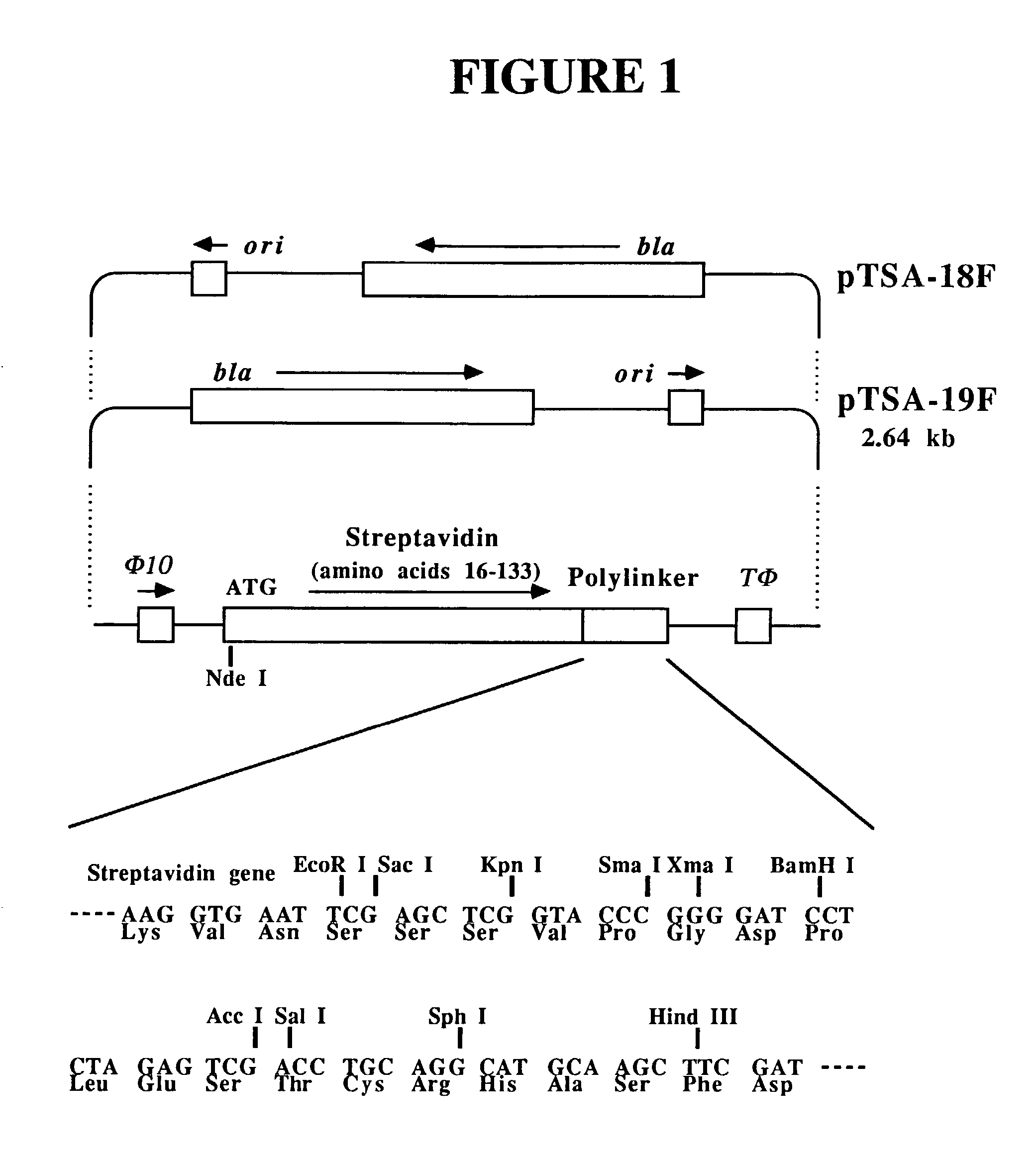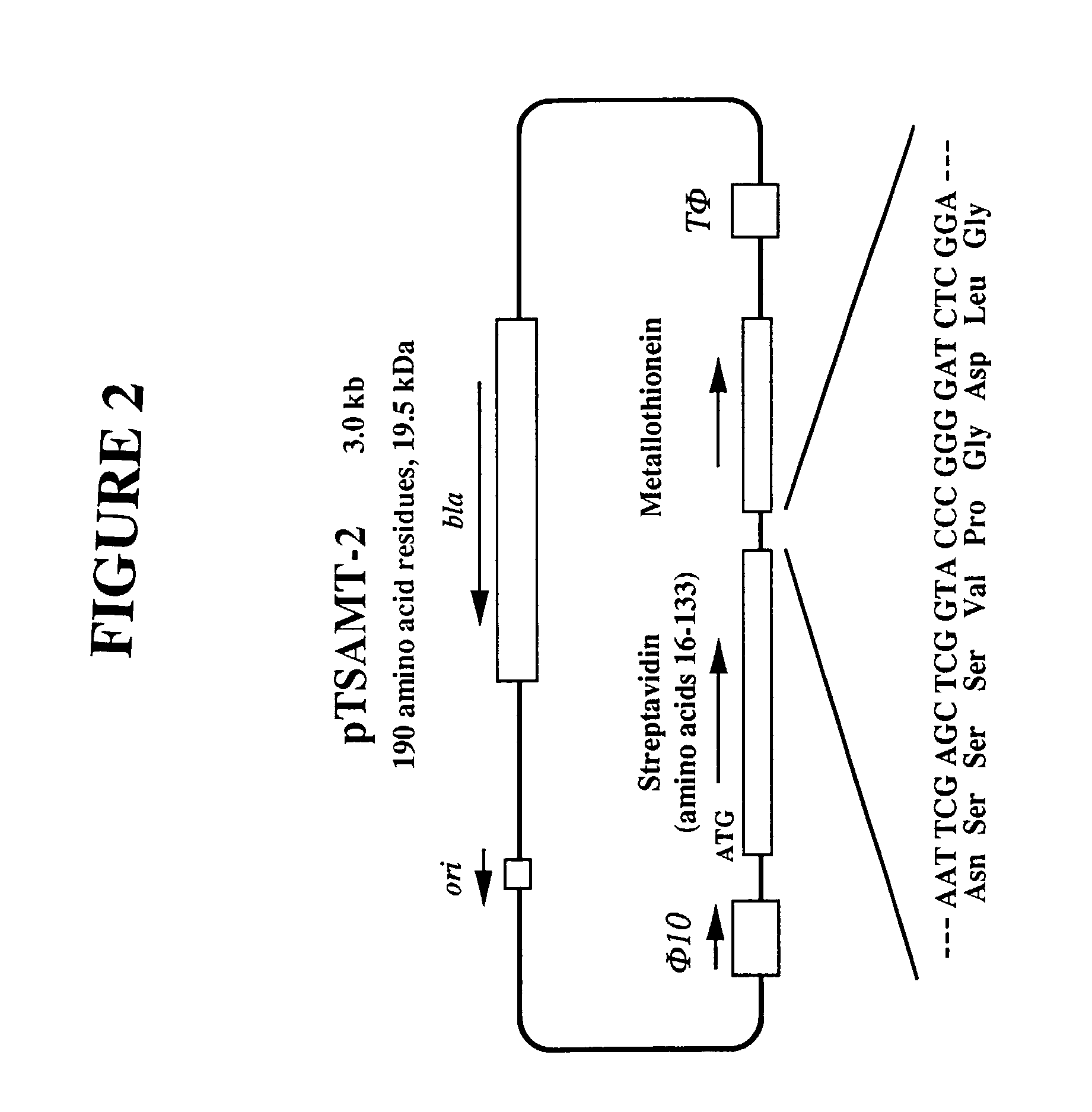Streptavidin proteins
a technology of streptavidin and proteins, which is applied in the field of streptavidin proteins, can solve the problems of low yield of metallothionein, no method reported, and extremely lethal effect of streptavidin gene on host cells
- Summary
- Abstract
- Description
- Claims
- Application Information
AI Technical Summary
Benefits of technology
Problems solved by technology
Method used
Image
Examples
example 2
Purification of Streptavidin-Metallothionein Chimeric Protein
[0098] This example illustrates purification of streptavidin-metallothione-in chimeric protein.
[0099] All procedures were carried out at 4.degree. C. or on ice. The culture (100 ml), containing lysogen BL21 (DE3)(pLysE) carrying the expression vector pTSAMT-2 incubated for 5 hours after the induction, was centrifuged at 2,900.times.g for 10 minutes. The cell pellet was suspended in 10 ml of 2 mM EDTA / 30 mM Tris-Cl, pH 8.0, containing 0. 1% Triton X-100, 10 mM dithiothreitol (DTT), and 0.1 mM phenylmethylsulfonyl fluoride (PMSF) to lyse the cells. The cell lysate was stored frozen at -70.degree. C.
[0100] To the thawed cell lysate (10 ml), PMSF, pepstatin A, and leupeptin were added to final concentrations of 1 mM, 1 .mu.M, and 1 .mu.M, respectively. The addition of the proteinase inhibitors was indispensable to prevent proteolysis of the expressed chimera during purification. The cell lysate was then treated with 10 pg / ml D...
example 3
Determination of Biotin and Metal-Binding Activity
[0101] This example illustrates methods to determine biotin and metal-binding ability of streptavidin-metallothionein chimeric protein.
[0102] Biotin-binding was determined by gel filtration method described in Methods Enzymol., 18A:424 (1970), using a PD-10 column and D-[carbonyl-.sup.14C]biotin (53 mCi / mmol).
[0103] Quantitative X-ray fluorescence analysis was employed to determine the metal-binding ability. The purified streptavidin-metallothionein chimeric protein (2.3 .mu.g, 120 pmol subunits) was dialyzed at 4.degree. C. against 0.2 M ammonium solution. The dialysate was lyophilized, and dissolved in 18 .mu.l of formic acid (95-97%, Aldrich). The dissolved sample (4 .mu.l) was spotted on a polypropylene membrane obtained from Chemplex Industries, Inc., East Chester, N.Y., and air-dried. The dried sample was subjected to quantitative X-ray fluorescence analysis according to Analytical Methods Applied to Air Pollution Measurements,...
example 4
Labeling of Streptavidin-Metallothionein Chimeric Protein with Radioactive Cd.sup.2+
[0104] This example illustrates labeling of streptavidin-metallothionein chimeric protein with radioactive cadmium.
[0105] The purified streptavidin-metallothionein chimeric protein (68 .mu.g, 3.5 nmol subunits) was dialyzed at 4.degree. C. against 10 mM DTT and then against 10 mM acetic acid, in which Chelex 100 (Bio Rad) was present. To the dialysate, 10 .mu.Ci of .sup.109CdCl.sub.2 (44 Ci / mmol, 0.23 nmol) in 0.1 M HCl and 25 nmol of ZnCl.sub.2 in 0.1 M HCl were added. The addition of Zn.sup.2+was to saturate the metal-binding sites of the chimera, and was indispensable to avoid aggregation of the chimera due to intermolecular disulfide formation by free sulfhydryl groups. The mixture was then dialyzed at 4.degree. C. against 0.2 M ammonium acetate, pH 7.0, which had been treated with Chelex 100. The dialysed protein was used as the sample. By this procedure, approximately 0.8% of the metal-binding ...
PUM
| Property | Measurement | Unit |
|---|---|---|
| molecular mass | aaaaa | aaaaa |
| temperatures | aaaaa | aaaaa |
| temperatures | aaaaa | aaaaa |
Abstract
Description
Claims
Application Information
 Login to View More
Login to View More - R&D
- Intellectual Property
- Life Sciences
- Materials
- Tech Scout
- Unparalleled Data Quality
- Higher Quality Content
- 60% Fewer Hallucinations
Browse by: Latest US Patents, China's latest patents, Technical Efficacy Thesaurus, Application Domain, Technology Topic, Popular Technical Reports.
© 2025 PatSnap. All rights reserved.Legal|Privacy policy|Modern Slavery Act Transparency Statement|Sitemap|About US| Contact US: help@patsnap.com


